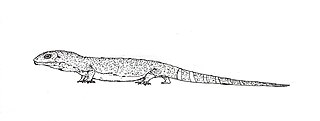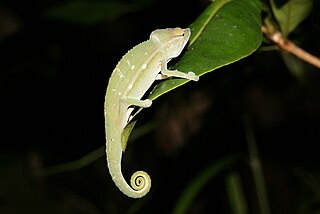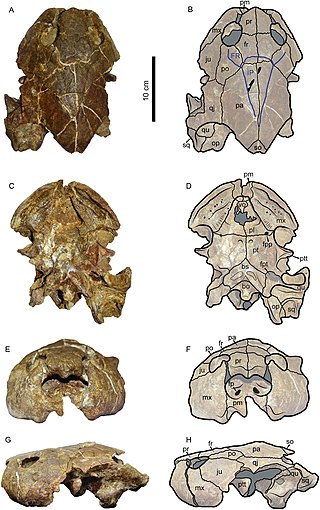
Chameleons or chamaeleons are a distinctive and highly specialized clade of Old World lizards with 200 species described as of June 2015. The members of this family are best known for their distinct range of colours, being capable of colour-shifting camouflage. The large number of species in the family exhibit considerable variability in their capacity to change colour. For some, it is more of a shift of brightness ; for others, a plethora of colour-combinations can be seen.

The Lacertidae are the family of the wall lizards, true lizards, or sometimes simply lacertas, which are native to Afro-Eurasia. It is a diverse family with at about 360 species in 39 genera. They represent the dominant group of reptiles found in Europe.

Calumma is a genus of chameleons, highly adapted and specialised lizards, in the family Chamaeleonidae. The genus is endemic to the island of Madagascar. One species, formerly known as Calumma tigris, was transferred to the genus Archaius in 2010, upon the discovery of its closer relation to Rieppeleon—one of several genera referred to collectively as "leaf" or "pygmy" chameleons—rather than to Calumma. The earliest known fossil of the genus is of Calumma benovskyi, from early Miocene Kenya, showing that the genus likely originated on mainland East Africa. The genus includes one of the heaviest and longest chameleon species, the Parson's chameleon.
Judeasaurus is an extinct genus of small, aquatic varanoid lizard related to the mosasauroids. The only known specimen is from the Late Cretaceous of the Judean Hills around Israel and the West Bank, though its exact provenance is uncertain.

Albanerpeton is an extinct genus of salamander-like albanerpetontid amphibian found in North America, Europe and Asia first appearing in Cretaceous-aged strata. There are eight described members of the genus, and one undiagnosed species from the Paskapoo Formation, making it by far the most speciose genus in the family. Members of the genus had a robust head and neck which likely allowed them to actively burrow, characteristic of fossorial species, and they lived in a wide range of environments. This genus of amphibian was the last of its order, surviving until into the Early Pleistocene (Gelasian) of northern Italy, and possibly northern Spain, until around 2 million years ago. It likely became extinct when the region developed its present Mediterranean-type climate, having preferred one that was cold and humid. The monophyly of Albanerpeton has recently been questioned, with some authors regarding the genus as paraphyletic.

Lazarussuchus is an extinct genus of amphibious reptile, known from the Cenozoic of Europe. It is the youngest known member of Choristodera, an extinct order of aquatic reptiles that first appeared in the Middle Jurassic. Fossils have been found in Late Paleocene, Late Oligocene, Early Miocene and possibly Late Miocene deposits in France, Germany, and the Czech Republic. Two species have been named: the type species L. inexpectatus ("unexpected") from the late Oligocene of France. and L. dvoraki from the early Miocene of the Czech Republic. It was not a large animal; with the total preserved body and tail length of L. inexpectatus being just over 30 centimetres. A complete specimen of Lazarussuchus with preserved soft tissue was found from the Late Paleocene of France, but has not been assigned to a species.
Aldabrachampsus is an extinct genus of small horned crocodile known from fragmentary remains. It lived during the Pleistocene on Aldabra Atoll, Seychelles in the western Indian Ocean. The name Aldabrachampsus dilophus means "Two-crested crocodile from Aldabra". It was a small animal, reaching a length of 2–2.5 m, comparable in size to the smallest extant crocodilians.

The Albanerpetontidae are an extinct family of small amphibians, native to the Northern Hemisphere during the Mesozoic and Cenozoic. The only members of the order Allocaudata, they are thought to be allied with living amphibians belonging to Lissamphibia. Despite a superficially salamander-like bodyform, their anatomy is strongly divergent from modern amphibians in numerous aspects. The fossil record of albanerpetontids spans over 160 million years from the Middle Jurassic to the beginning of the Pleistocene, about 2.13–2 million years ago.

Plesiotylosaurus, meaning "near Tylosaurus", is an extinct genus of marine lizard belonging to the mosasaur family. It is classified as part of the Mosasaurinae subfamily, alongside genera like Mosasaurus and Prognathodon. The genus contains one species, Plesiotylosaurus crassidens, recovered from deposits of Middle Maastrichtian age in the Moreno Formation in California.

Asiatosuchus is an extinct genus of crocodyloid crocodilians that lived in Eurasia during the Paleogene. Many Paleogene crocodilians from Europe and Asia have been attributed to Asiatosuchus since the genus was named in 1940. These species have a generalized crocodilian morphology typified by flat, triangular skulls. The feature that traditionally united these species under the genus Asiatosuchus is a broad connection or symphysis between the two halves of the lower jaw. Recent studies of the evolutionary relationships of early crocodilians along with closer examinations of the morphology of fossil specimens suggest that only the first named species of Asiatosuchus, A. grangeri from the Eocene of Mongolia, belongs in the genus. Most species are now regarded as nomina dubia or "dubious names", meaning that their type specimens lack the unique anatomical features necessary to justify their classification as distinct species. Other species such as "A." germanicus and "A." depressifrons are still considered valid species, but they do not form an evolutionary grouping with A. grangeri that would warrant them being placed together in the genus Asiatosuchus.

Euthecodon is an extinct genus of long-snouted crocodile. It was common throughout much of Africa during the Neogene, with fossils being especially common in Kenya, Ethiopia, and Libya. Although superficially resembling that of gharials, the long snout was a trait developed independently from that of other crocodilians and suggests a diet of primarily fish. Euthecodon coexisted with a wide range of other crocodiles in the areas it inhabited before eventually going extinct during the Pleistocene.

Phosphorosaurus is an extinct genus of marine lizard belonging to the mosasaur family. Phosphorosaurus is classified within the Halisaurinae subfamily alongside the genera Pluridens, Eonatator, and Halisaurus.

Chamaeleoninae is the nominotypical subfamily of chameleons. The Family Chamaeleonidae was divided into two subfamilies, Brookesiinae and Chamaeleoninae, by Klaver and Böhme in 1986. Since its erection in 1986, however, the validity of this subfamily designation has been the subject of much debate, although most phylogenetic studies support the notion that the pygmy chameleons of the subfamily Brookesiinae are not a monophyletic group. While some authorities have previously preferred to use the subfamilial classification on the basis of the absence of evidence principal, these authorities later abandoned this subfamilial division, no longer recognizing any subfamilies with the family Chamaeleonidae. In 2015, however, Glaw reworked the subfamilial division by placing only the genera Brookesia and Palleon within the Brookesiinae subfamily, with all other genera being placed in Chamaeleoninae.

Warkalania is an extinct genus of Australian meiolaniid turtle from the Oligocene or early Miocene of Riversleigh, Queensland. While other meiolaniids are known for their elaborate headcrests or long horns, Warkalania only possesses very short horns that form a somewhat continuous ridge across the back of the head. The only known species of this genus, Warkalania carinaminor, is the oldest named meiolaniid turtle of Australia.

Crocodylus checchiai is an extinct species of crocodile from the Miocene to Pliocene of Libya and Kenya. C. checchiai was named in 1947 based on a skull from the Sahabi Formation. Remains from the lower Nawata Formation in the Turkana Basin of Kenya that were first attributed to the Nile crocodile have now been reassigned to C. checchiai, extending its geographic range. The morphology of the species, in particular the pronounced rostral boss, indicates that it may be the connecting link between African and American species of the genus Crocodylus.

Calumma nasutum, the Madagascar pimple-nose chameleon, is a small species of chameleon found in Madagascar. The taxonomic identity of the species is currently uncertain and in need of revision, and this revision is likely to result in several newly described species. Several different data sets indicate that C. nasutum is a complex of several species.
Oardasaurus is an extinct genus of lizard from the latest Cretaceous of Romania. It is a member of the Barbatteiidae, a group of lizards closely related to the Teiidae. At 20 centimetres (7.9 in) in length, it was much smaller than the only other named member of the Barbatteiidae, Barbatteius, which lived slightly later. Like Barbatteius, Oardasaurus can be identified by the presence of a crust of bone deposits, or osteoderms, on the roof of its skull; it differs from Barbatteius in the pattern of the sculpturing on this crust. Both Oardasaurus and Barbatteius lived in the isolated island ecosystem of Hațeg Island, having rapidly diversified into various generalist predators of small prey after their arrival on the island during the Early Cretaceous. They went extinct in the Cretaceous–Paleogene extinction event.

Caninemys is an extinct genus of large freshwater side-necked turtle, belonging to the family Podocnemididae. Its fossils have been found in Brazil and Colombia, in rocks dating back from the middle to late Miocene.

Chamaeleo intermedius is an extinct species of chameleon from the Miocene of Kenya. It was given its name based on the fact that it shares traits with both species of the genus Chamaeleo and those of Trioceros, which at the time were placed in the same genus. This belief that it was an intermediate form was however rejected by later research.

Paranacaiman is an extinct genus of large caiman from the Late Miocene Ituzaingó Formation of Argentina. The holotype, a skull table, was part of the hypodigm for "Caiman lutescens", which was later found to be a nomen dubium. Since a lectotype had been erected for "C. lutescens", the skull table was not name-bearing and was thus used to erect Paranacaiman. The genus is monotypic, meaning it only contains a single species: Paranacaiman bravardi.





















